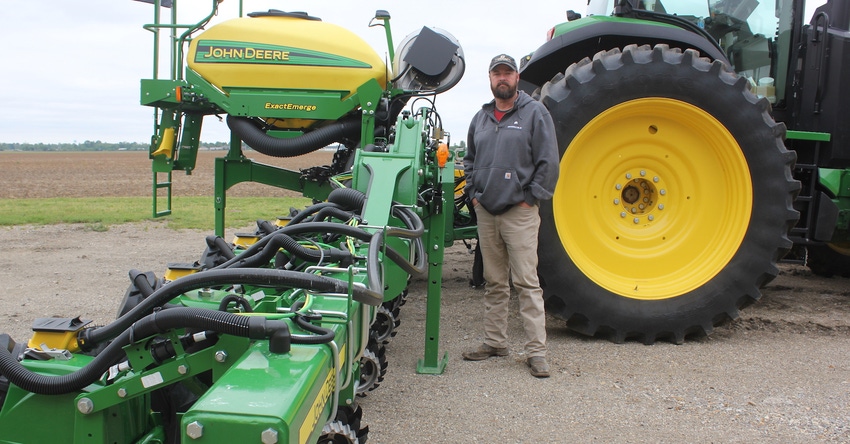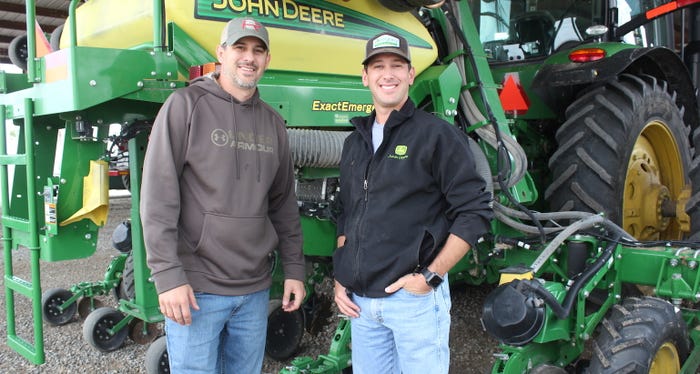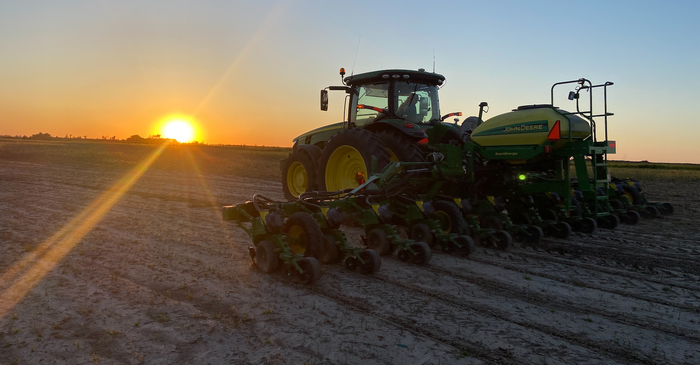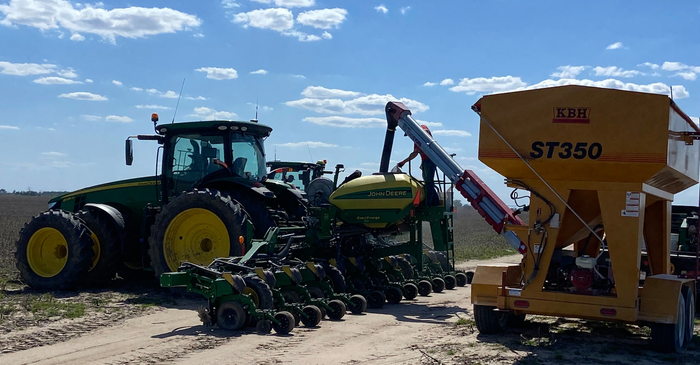
It was a cool, wet start to May in the North Delta … again. This apparent weather trend once more pushed a lot of planting to the latter part of the month — causing more than a little worry among the region’s producers, particularly cotton growers.
But Patrick Turnage, a cotton farmer near Hayti, Mo., was unphased by the late start, and for several reasons. First, as a part owner of Caruthersville Gin, he’s committed to cotton. And while he isn’t a fan of planting it in June, as he puts it, “I’ll plant to May 34th.”
Another reason for his confidence is his experience with high-speed planters.
“With these two planters, we’re capable of planting 500 to 800 acres of cotton a day, no problem,” Turnage said. “Even with a tight planting window, I know I can get my crop in the ground. It’s like an insurance policy in itself.”
In 2018, Turnage replaced four chain-drive planters with two John Deere ExactEmerge high-speed planter systems. ExactEmerge advertises accurate seed placement at speeds of up to 10 miles per hour. That’s twice the speed of most traditional planters.
Turnage was one of the first farmers in the Missouri Bootheel to try a high-speed planter. He says the investment has changed the way he farms.
“With input costs we want to plant it one time and get it right,” said Turnage, who farms roughly 6,000 acres with his father. “That’s the advantage of these fast planters, the amount of ground you can cover in one day. In my mind, it’s the most revolutionary piece of equipment since the round bale picker.”

Widening the window
About 20 miles to the north in Marston, Mo., brothers Lee and Blake Richardson are also big fans of high-speed planters. Like Turnage, they invested in a John Deere Exact Emerge in 2018. They now have four Exact Emerge models that do all the planting on their family’s 12,000-acre farm.
“Basically, it doubles the number of acres you can cover in a day with less labor, since we went from six planters to four,” Blake said. “That’s two less people dedicated to planting who can be on other equipment. That just helps your whole operation.”
“Here in the northern Delta our planting windows are so small. We have five to seven days to get our seed in or we’re out of time,” Lee adds. “With our ability to plant at such high speeds, one day doesn’t make that much difference to us anymore. We can wait another day to let the ground dry or let soil temperatures warm up. These planters give you that option.”
High-speed planters are certainly not new, but adoption of the technology has not exactly been widespread, either, particularly here in the Delta. However, the Richardsons and Turnage all say they’re seeing more interest in high-speed planters from neighboring farmers as producers look for ways to increase efficiency, reduce labor requirements, and of course, overcome spring weather challenges. Also, with used models becoming more readily available, these planters could be more attainable. These Missouri farmers shared with us how they’re using high-speed planters in their operations, how they justified the significant investment, and the unforeseen benefits they’ve discovered.
Richardson Farm
Lee and Blake Richardson farm with their father and grandfather. Their family also owns Richardson Gin in nearby Marston. Their crop mix is split pretty evenly between cotton and soybeans. 2020 was the first year they planted a lot of cotton with their high-speed planters. Before that, they used them mostly in soybeans.
The first thing they will tell you about a high-speed planter is there’s no way to prepare yourself for how fast it goes.
“It’s crazy. It didn’t feel right the first few times. You kept thinking there’s no way the seed can be going in the ground that fast, said Blake.”

The second thing you’ll most likely hear is praise for the accuracy of the seed placement.
“We’re seeing 99% singulation,” said Lee. “When we demoed these, they dug up a quarter mile row and could not find a single double seed.”
The Richardsons run their planters between 9-10 miles per hour to achieve that 99% rate. At those speeds, they say each planter can get 350-400 acres of cotton planted in a day and roughly 300 acres of soybeans. At that rate, with four planters, they could plant their entire 12,000-acre farm in less than 10 days’ time.
Seed savings
By eliminating almost all double planting with the improved singulation and reducing overlaps with the automatic section control feature, the Richardsons are also seeing significant seed savings.
“These planters are expensive, but then so is seed,” Lee said. “The savings you have because seed is placed precisely, you take that across your whole farm, and that’s a lot of savings.”
They say maintenance issues have gone down and efficiency is way up. They’ve used the planters in no-till, conventional till, and minimal till on different soil types, all with the same results. They’ve learned through trial and error to increase the amount of graphite and talc added to the planter, due to the volume of seeds running through. Other than that, their only complaint is that keeping the seed to them can be difficult, especially in soybeans.
“If we ran all four planters in soybeans, we’d be running out of seed for sure,” Blake said. “That’s why I like running at 9 miles per hour. At 10, you’re probably just going to be waiting on seed.”

Blake adds the new planters have allowed them to be earlier with soybean planting, which was an unexpected benefit. This year the Richardsons had planted about 2,500 acres of soybeans by early May.
“Before, you had to hook up two or three planters to get a lot of acres in early and make it worth your effort. Now one or two men can get a significant amount of planting done, where you couldn’t do that before,” Blake said.
Turnage Farms
Back in Hayti, Turnage says planting season is fun again. That’s mostly due to increased confidence in getting his acres planted timely, but it also may have a little to do with getting to drive fast.
“It’s like being in a top-fuel dragster,” Turnage said. “It’s intense until you get used to it.”
Turnage, who uses his high-speed planters exclusively in cotton, is a little less conservative with his speedometer, confessing he runs his planters at 13 miles per hour. Even at the faster pace, he says he’s still achieving seed placement accuracy near 97%, which in his words is “plenty perfect.” With those singulation rates, he was confident seed savings would offset the costs of the planters.
He says his favorite feature is the convenience of making adjustments on the go from the tractor cab. With a push of a button, he can run row cleaners or change plant populations on the fly. He took advantage of this innovation to begin his own plant population research trials.
“After doing the population trials over the last three years, I’ve actually increased my seed population,” Turnage said. “On my farm, I learned that the 46,000-48,000 seed range not only brought a better yield, but also the thicker the cotton was planted, the faster it matured. So, I ended up not saving so much on seed costs, but through my research I’ve gained yield and increased earliness. And, of course, here in the North Delta time is money.”

Turnage plants 4,000 acres of cotton on farms in Missouri and Tennessee. With two high speed planters, he can typically finish planting in eight days. This year he says he did it in six days — getting 700 acres in nine hours on one of his Tennessee farms.
“And that’s coming back to the shop to fill up with seed,” he clarified. “We don’t run seed tenders with cotton. Since the planters will hold a bulk box, I purchased a chute that latches onto the box, and using a forklift we’ll fill up that way. We can fill a planter in about seven minutes.”
Like the Richardsons, he’s experienced less maintenance issues with these planters and insists they are capable of planting anywhere.
“With it being electric drive, as long as the one drive tire will roll, it will plant. We have planted in the most awful mud you’ve ever seen and didn’t have one minute’s trouble.”
Based on his experiences, he would advise growers, especially cotton growers, to give these planters a look.
“In my mind, they’re like a round bale picker. I wouldn’t want to plant cotton without them.”
About the Author(s)
You May Also Like






